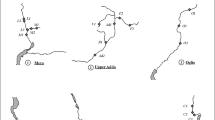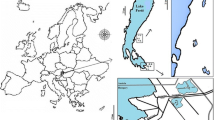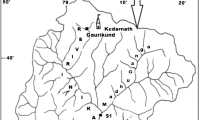Abstract
Soda pans are protected in the European Union as Natura 2000 areas in the category of “Pannonic saline steppes and marshes”. There are at least six soda pans of reference status in Serbia and only a half have strict legal protection. The number of similar, but disturbed (modified) habitats that could be reconstructed is still unknown. We conducted sampling in five natural and two disturbed soda pans aiming to compare a difference in physical and chemical water properties and benthic diatom communities. In addition, we tried to apply recently developed Diatom Index for Soda Pans (DISP) and Trait-based index (TBI) to test the applicability of taxonomic and trait-based approaches in ecological status assessment of soda pans in the southern part of the Carpathian Basin. In contrast to natural soda pans, lower pH and nutrients levels were recorded in disturbed pans. A total of 86 taxa of benthic diatoms, including 11 new for diatom flora of Serbia, were identified. A lower species richness and Shannon index was recorded in natural soda pans. Nitzschia austriaca, N. supralitorea, Navicula veneta and N. wiesneri were dominant diatoms in soda pans of the reference status. Both diatom indices were in average lower in disturbed pans, and this difference was statistically significant for DISP index. We concluded that two indices, supplemented with indicator values for some local diatom species, can be a promising tool for soda pan conservation in this part of the Carpathian Basin.





Similar content being viewed by others
Data availability
The authors confirm that the data supporting the findings of this study are available within the article and its supplementary materials.
References
Ács É (2007) A Velencei-tó bevonatlakó algáinak tér- és idöbeli változása, kapcsolata a tó ökológiai állapotával – Spatial and temporal change of epiphytic algae and their connection with the ecological condition of shallow lake Velencei-tó (Hungary). Acta biol Debr oecol Hung 17:9–111
Ács É, Földi A, Wetzel CE, Vad CF, Kiss KT, Dobosy P, Trábert Z, Grigorszky I, Engloner A, Ector L (2017) Nitzschia austriaca hustedt: a characteristic diatom of Hungarian inland saline waters including a morphological comparison with the type material. Phytotaxa 308:54–65
Ács É, Földi A, Vad CF, Trábert Z, Kiss KT, Duleba M, Borics G, Grigorszky I, Botta-Dukát Z (2019) Trait-based community assembly of epiphytic diatoms in saline astatic ponds: a test of the stress-dominance hypothesis. Sci Rep 9:15749. https://doi.org/10.1038/s41598-019-52304-4
APHA, AWWA, WPCF (1995a) Method 2320 B. In: Eaton AD, Clesceri LS, Greenberg AE (eds) Standard methods for the examination of water and wastewater, 19th edn. American Public Health Association, American Water Works Association and Water Pollution Control Federation, Washington, pp 2–26
APHA, AWWA, WPCF (1995b) Method 4500-Cl- B. In: Eaton AD, Clesceri LS, Greenberg AE (eds) Standard methods for the examination of water and wastewater, 19th edn. American Public Health, Association American Water Works Association and Water Pollution Control Federation, Washington, pp 4–49
APHA, AWWA, WPCF (1995c) Method 4500-SO42- C. In: Eaton AD, Clesceri LS, Greenberg AE (eds) Standard methods for the examination of water and wastewater, 19th edn. American Public Health Association, American Water Works Association and Water Pollution Control Federation, Washington, pp 4–135
Bak M, Szlauer-Łukaszewska A (2012) Bioindicative potential of diatoms and ostracods in the Odra mouth environment quality assessment. Nov Hedwigia, Beih 141:463–484
Blinn WD (1993) Diatom community structure along physicochemical gradients in saline lakes. Ecology 74:1246–1263
Boros E, Kolpakova M (2018) A review of the defining chemical properties of soda lakes and pans: an assessment on a large geographic scale of Eurasian inland saline surface waters. PLoS ONE. https://doi.org/10.1371/journal.pone.0202205
Boros E, Ecsedi Z, Oláh J (2013) Ecology and Management of Soda Pans in the Carpathian Basin. Hortobágy Environmental Association, Balmazújváros
Boros E, Horváth Z, Wolfram G, Vörös L (2014) Salinity and ionic composition of the shallow astatic soda pans in the Carpathian Basin. Ann Limnol Int J Limnol 50:59–69. https://doi.org/10.1051/limn/2013068
Földi A, Ács É, Grigorszky I, Ector L, Wetzel CE, Várbíró G, Kiss KT, Dobosy P, Trábert Z, Borsodi AK, Duleba M (2018) Unexpected consequences of bombing. Community level response of epiphytic diatoms to environmental stress in a saline bomb crater pond area. PLoS ONE 13:e0205343. https://doi.org/10.1371/journal.pone.0205343
Gavrilović B, Ćirić M, Vesić A, Vidaković D, Novaković B, Živanović M (2018) Biodiversity overview of soda pans in the Vojvodina region (Serbia). J Geogr Inst Jovan Cvijić, SASA 68:195–214. https://doi.org/10.2298/ijgi1802195g
Grant WD (2006) Alkaline environments and biodiversity. In: Gerday C, Glansdorff N (eds) Extremophilies, encyclopedia of life support systems (EOLSS). EOLSS Publishers, Oxford, pp 21–38
Hammer UT (1986) Saline lake ecosystems of the World. Junk Publishers, The Hague
Heudre D, Wetzel CE, Van de Vijver B, Moreau L, Ector L (2020) Brackish diatom species (Bacillariophyta) from rivers of Rhin-Meuse basin in France. Bot Lett 1:11. https://doi.org/10.1080/23818107.2020.1738269
Hillebrand H, Dürselen CD, Kirschtel D, Pollingher U, Zohary T (1999) Biovolume calculation for pelagic and benthic microalgae. J Phycol 35:403–424. https://doi.org/10.1046/j.1529-8817.1999.3520403.x
Krizmanić J (2009) Floristic, taxonomical and ecological investigations of raphid diatoms (Bacillariophyceae, Bacillariophycideae, Bacillariophyta) in Serbia. Dissertation, University of Belgrade, Faculty of Biology (in Serbian).
Lange-Bertalot H (2001) Navicula sensu stricto. 10 genera separated from Navicula sensu lato, Frustulia Diatoms of Europe 2. A.R.G. Gantner Verlag. K.G., Ruggell
Lange-Bertalot H, Hofmann G, Werum M, Cantonati M (2017) Freshwater benthic diatoms of Central Europe: over 800 common species used in ecological assessments. English edition with updated taxonomy and added species. Koeltz Botanical Books, Schmitten-Oberreifenberg
Lengyel E, Padisák J, Hajnal É, Szabó B, Pellinger A, Stenger-Kovács C (2016) Application of benthic diatoms to assess efficiency of conservation management: a case study on the example of three reconstructed soda pans, Hungary. Hydrobiologia 777:95–110. https://doi.org/10.1007/s10750-016-2768-9
Petrović G (1980) Physico-chemical aspects of alkaline ponds in Yugoslavia. Dev Hydrobiol 3:89–95
Potapova M, Hamilton PB (2007) Morphological and ecological variation within the Achnanthidium minutissimum (Bacillariophyceae) species complex. J Phycol 43:561–575. https://doi.org/10.1111/j.1529-8817.2007.00332.x
Rimet F, Ector L, Cauchie HM, Hoffmann L (2009) Changes in diatom-dominated biofilms during simulated improvements in water quality: implications for diatom-based monitoring in rivers. Eur J Phycol 44:567–577. https://doi.org/10.1080/09670260903198521
SRPS EN 12260:2008 Water quality - determination of nitrogen - determination of bound nitrogen (tnb), following oxidation to nitrogen oxides. Institute for standardization of Serbia. Institute for Standardization of Serbia, Belgrade
SRPS EN ISO 6878:2008 Water quality - determination of phosphorus - ammonium molybdate spectrometric method (ISO 6878:2004). Institute for Standardization of Serbia, Belgrade
SRPS EN ISO 14911:2009 Water Quality - Determination of dissolved Li+, Na+, NH4+, K+, Mn2+, Ca2+, Mg2+, Sr2+ and Ba2+ using ion chromatography - Method for water and waste water. Institute for Standardization of Serbia, Belgrade
Stenger-Kovács C, Lengyel E (2015) Taxonomical and distribution guide of diatoms in soda pans of Central Europe. Stud Bot Hungarica 46:3–203
Stenger-Kovács C, Buczkó K, Hajnal É, Padisák J (2007) Epiphytic, littoral diatoms as bioindicators of shallow lake trophic status: Trophic Diatom Index for Lakes (TDIL) developed in Hungary. Hydrobiologia 589:141–154. https://doi.org/10.1007/s10750-007-0729-z
Stenger-Kovács C, Lengyel E, Buczkó K, Tóth FM, Crossetti LO, Pellinger A, Doma ZZ, Padisák J (2014) Vanishing world: alkaline, saline lakes in Central Europe and their diatom assemblages. Inl Waters 4:383–396. https://doi.org/10.5268/IW-4.4.722
Stenger-Kovács C, Hajnal LE, Buczkó K, Padisák J (2016) A test of traditional diversity measures and taxonomic distinctness indices on benthic diatoms of soda pans in the Carpathian basin. Ecol Indic 64:1–8. https://doi.org/10.1016/j.ecolind.2015.12.018
Stenger-Kovács C, Körmendi K, Lengyel E, Abonyi A, Hajnal É, Szabó B, Buczkó K, Padisák J (2018) Expanding the trait-based concept of benthic diatoms: development of trait- and species-based indices for conductivity as the master variable of ecological status in continental saline lakes. Ecol Indic 95:63–74. https://doi.org/10.1016/j.ecolind.2018.07.026
Stenger-Kovács C, Lengyel E, Buczkó K, Padisák J, Korponai J (2020) Trait-based diatom functional diversity as an appropriate tool for understanding the effects of environmental changes in soda pans. Ecol Evol 10:320–335. https://doi.org/10.1002/ece3.5897
Taylor JC, Harding WR, Archibald CGM (2007) WRC Report TT 281/07: A methods manual for the collection, preparation and analysis of diatom samples version 1.0. Water Research Commission, The Republic of South Africa
Tóth A, Horváth Z, Vad CF, Zsuga K, Nagy SA, Boros E (2014) Zooplankton of the European soda pans: fauna and conservation of a unique habitat type. Int Rev Hydrobiol 99:255–276. https://doi.org/10.1002/iroh.201301646
U.S. EPA (1997) Method 300.1: Determination of Inorganic Anions in Drinking Water by Ion Chromatography (revision 1.0). U.S. Environmental Protection Agency, Cincinnati, OH
Van Dam H, Mertens A, Sinkeldam J (1994) A coded checklist and ecological indicator values of freshwater diatoms from the Netherlands. Neth J Aquat Ecol 28:117–133. https://doi.org/10.1007/BF02334251
Van de Vijver B, Lange-Bertalot H (2009) New and interesting Navicula taxa from western and northern Europe. Diatom Res 24:415–429. https://doi.org/10.1080/0269249X.2009.9705811
Vidaković D, Krizmanić J, Dojčinović BP, Pantelić A, Gavrilović B, Živanović M, Novaković B, Ćirić M (2019) Alkaline soda lake Velika Rusanda (Serbia): the first insight into diatom diversity of this extreme saline lake. Extremophiles 23:347–357. https://doi.org/10.1007/s00792-019-01088-6
Williams WD (2002) Environmental threats to salt lakes and the likely status of inland saline ecosystems in 2025. Environ Conserv 29:154–167. https://doi.org/10.1017/S0376892902000103
Funding
This work was financially supported by the Ministry of Education, Science and Technological Development of the Republic of Serbia (Grants No. 451-03-68/2020-14/200026 and 451-03-68/2020-14/200178).
Author information
Authors and Affiliations
Contributions
MĆ developed the main idea for the study, wrote the main part of the manuscript and produced the statistical output. BG assisted in the study design and proofreading of the text. The literature study was done by JK. Chemical analyses and an interpretation of the relationship between ions in saline water was carried out by BPD. DV identified and counted diatoms, produced the graphics and helped with the field work.
Corresponding author
Ethics declarations
Conflict of interest
The authors have no conflicts of interest to declare that are relevant to the content of this article.
Informed consent
Informed consent was obtained from all individual participants included in the study. The participant has consented to the submission of the original paper to the journal.
Additional information
Publisher's Note
Springer Nature remains neutral with regard to jurisdictional claims in published maps and institutional affiliations.
Supplementary Information
Below is the link to the electronic supplementary material.
Rights and permissions
About this article
Cite this article
Ćirić, M., Gavrilović, B., Krizmanić, J. et al. Can a benthic diatom community complement chemical analyses and discriminate between disturbed and undisturbed saline wetland habitats? A study of seven soda pans in Serbia. Wetlands Ecol Manage 29, 451–466 (2021). https://doi.org/10.1007/s11273-021-09794-9
Received:
Accepted:
Published:
Issue Date:
DOI: https://doi.org/10.1007/s11273-021-09794-9




